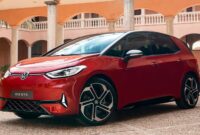Modern vehicles are equipped with a wide range of driver-assist systems, but a new study from AAA emphasizes these are designed to assist drivers, not take the place of smart, attentive behavior behind the wheel. That holds especially true with reverse automatic emergency braking systems, which AAA found sorely lacking in the ability to prevent collisions.
What does sorely lacking mean? Out of 40 test runs using four SUVs from different automakers, only one ended without a crash from cross traffic. Arguably more surprising is the 50-percent failure rate for stationary people standing behind the SUVs. 10 out of 20 tests ended with SUVs striking a child-sized pedestrian target, and five of those times the automatic braking system never even activated.

Those are the results, but let’s take a deeper dive into the test and the vehicles involved. AAA sourced a Hyundai Tucson, Volkswagen Tiguan, Mazda CX-30, and a Lexus RX 350, all 2023 models that AAA says are representative of popular small-to-medium-sized SUVs in use today.
Two scenarios were used for testing cross-traffic alerts and braking: reversing from perpendicular spots and from angled spaces, both with a large vehicle parked to the right. For the stationary pedestrian test, a human figure standing 45 inches tall was placed approximately six feet behind the SUV on the vehicle’s center line.
For cross-traffic tests, a robotic soft-target vehicle served as the traffic. In both scenarios, it approached at 15 mph. The SUVs began reversing when the target was 200 feet out. No pressure was applied to either the accelerator or brake pedal, thus leaving everything up to the safety system. Each SUV performed the tests five times, and the Volkswagen Tiguan is the only one that avoided a crash, albeit just once in the perpendicular test.
Angled parking seems to be particularly tricky for the systems. None avoided collisions and all SUVs failed to even activate the brakes on some runs. Overall stats show brakes were applied on just 45 percent of the angled parking tests, versus 85 percent for the perpendicular runs. The Lexus RX 350 was the only vehicle that didn’t brake on any of the angled tests.

As for pedestrians, the study shows a 50 percent chance of hitting a person standing directly behind the vehicle. The Tiguan, while being the only SUV to avoid a cross-traffic collision, hit the simulated kid in every test. It didn’t even apply the brakes on two of those tests, but the Mazda CX-30 was worse. It also hit the pedestrian every run and failed to brake three times. Yikes.
“Drivers should not solely rely on these advanced driving systems to prevent collisions, but instead use them to enhance their awareness of their surroundings and support safe driving,” said Greg Brannon, AAA director of automotive engineering. “Above all, vehicle testing requirements for these systems should be updated to be consistent, taking into consideration unusual objects and more realistic scenarios with the goal of achieving the greatest safety benefit to drivers, pedestrians, and cyclists.”
We reached out to the automakers mentioned in this test for some insight into their safety systems. Lexus explained its Rear Cross Traffic Braking system alerts drivers first, then applies the brakes to help avoid or mitigate contact but it’s not designed to stop the vehicle completely. Even if it does stop, the brakes will be released after approximately two seconds. Lexus also echoed AAA’s thoughts with the following statement:
“Lexus vehicles are available with several different Parking Support technologies designed to help make the driver aware of potential obstacles around the vehicle, vehicles crossing behind the Lexus when in reverse, or pedestrians near the rear of the vehicle, alert the driver, and in the case of some systems, take action if they determine that a collision is likely. As they may not function correctly under certain conditions, the driver’s own visual confirmation of safety is necessary. The driver is solely responsible for safe driving.”
Volkswagen offered a similar statement regarding its rear auto brake system:
“The safety of our customers is a top priority for Volkswagen. Our driver assistance systems are designed to aid drivers, but are not substitutes for attentive driving. As the study recommends, drivers should be fully aware of their surroundings, utilize backup cameras to enhance their awareness, and back up cautiously.”
Hyundai shared a description of its Rear Cross-Traffic Collision-Avoidance Assist (RCCA) system, which states the vehicle “may even apply the brakes automatically if needed.” Mazda didn’t have anything to say at the time of publication but we should have statements from both Mazda and Hyundai regarding the test shortly. We will add those as soon as they’re available.
The full AAA study offers a considerably deeper dive into the methodology and parameters of the test, but the takeaway is pretty simple. Reversing systems that detect objects and have auto brake capability offer a level of assistance, but nothing more. Drivers still need to exercise caution and be vigilant when backing up.



